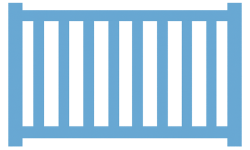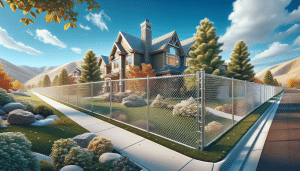Are you a homeowner dealing with damage-prone boundaries or just looking to enhance your property’s security? Our comprehensive guide on residential Chain Link Fence Installation comes to the rescue. Perfectly tailored for residents in Utah, we’ll walk you through the entire process to ensure clarity and confidence throughout your project.
Why Choose a Chain Link Fence?
Chain link fences have become a popular choice among homeowners due to their affordability and durability. These fences provide a long-lasting solution without burning a hole in your pocket. With proper installation and minimal maintenance, they seamlessly blend function with form, providing unobtrusive security and boundary control.
Moreover, chain link fences are versatile, yielding to a variety of landscaping styles and weather conditions. This adaptability makes them perfect for our diverse climate zones, offering reliable performance year after year.
Gathering Necessary Materials
Before you begin, it’s crucial to gather all of the essential materials and tools. For an efficient installation, having everything on hand saves time and reduces interruptions during the process. Here’s a checklist to guide you:
You’ll need chain link fence fabric, posts, rails, tension bands, and wire. Also, arm yourself with tools like post hole diggers, wrenches, and a string line for measurements. Purchase quality materials from a reliable source to ensure long-term reliability.
Planning and Measuring Your Fence Line
The success of your fence installation largely depends on precise planning and measurements. Start by determining your property line and mapping out the exact perimeter your fence will cover. Clear communication with your neighbors will prevent potential disputes and ensure community harmony.
Use stakes and string lines to establish a clear visual of your fence layout. Measure the distance between each post accurately; this ensures evenly spaced sections, which contribute to a neat, professional appearance.
Preparing the Ground
Once you’ve defined your fence line, preparation of the ground forms the next pivotal step. Clear any obstructions like rocks, debris, or vegetation that may interfere with the installation. Leveling high spots or filling low areas can also maximize fence stability.
With a solid foundation ready, you’ll prevent potential future misalignments or structural issues with your fence. Our experience at Utah Fencing Company shows that proper prep work is the backbone of a durable fence.
Installing the Fence Posts
Fence posts serve as the framework of your entire setup. Begin by digging holes for each post at a uniform depth and width, typically one-third of the post’s height. This ensures stability against environmental pressures like wind or weight.
Insert the posts into the dug holes and fill with Concrete for extra support. Align the posts vertically using a level, and let the concrete cure as per manufacturer’s guidelines before proceeding with the next steps.
Attaching Tension Bands and Rails
Once your posts are securely set, attaching tension bands and top rails is your next priority. Tension bands are vital for securing the chain link fabric to the posts, ensuring a tight, secure fit. Space them evenly along the post’s height for uniform tension and aesthetics.
Fix the top rail to each post, offering structural integrity and alignment to the fence panels. This step ensures your chain link fabric remains taut, enhancing the fence’s overall appearance and longevity.
Unrolling and Attaching the Chain Link Fabric
Unrolling the chain link fabric is where your fence begins to take shape visually. Start at one end, gradually unwinding it alongside the posts. Allow the fabric to lay flat, avoiding creases or twists which might cause uneven installation.
Secure one end of the fabric to a terminal post using tension bars and fasten it with the tension bands. Gradually stretch the fabric to the next post, maintaining consistent tension to achieve a professional finish. Tighten any slack using a tension bar to promote fence durability.
Final Adjustments and Checking Alignment
With your chain link firmly in place, it’s time for final adjustments and alignment checks. Ensure all sections are uniformly tight and make necessary tweaks to eliminate any irregularities. Consistency and a keen eye for detail create an impressive parallel across your entire fence line.
Walk along the perimeter with a level and plumb line, confirming every element is straighter than a ruler. This extra bit of care ensures not only functionality but also enhances your property’s curb appeal.
Installation Maintenance Tips
Once installed, your chain link fence requires minimal upkeep. Periodically check for any signs of wear or tension loss, especially post-storms or seasonal changes. Regularly tightening loose sections can prevent bigger issues down the line.
For further protection, you might consider applying a weather-resistant coating to extend the fabric’s life. Little steps like these maintain your investment’s value, ensuring your chain-link fence stands strong without excessive maintenance costs.
Common Mistakes to Avoid
- Inaccurate Measurements: Misjudging measurements can lead to uneven posts and a skewed fence line. Always double-check your measurements for precision.
- Ignoring Property Lines: Overstepping boundaries may cause disputes with neighbors. Confirm exact property lines before beginning to install.
- Skipping Ground Prep: Foregoing proper ground preparation can compromise the fence’s stability and appearance. Always clear and level the area first.
- Underestimating Tension: Loosely attached fabric can sag over time. Correct tension is crucial for longevity and aesthetic appeal.
- Using Low-Quality Materials: Bargain materials may initially save money but often lead to frequent repairs. Invest in quality for long-lasting results.
Conclusion and Next Steps
By following our comprehensive guide, you’re well on your way to a secure and aesthetically pleasing chain link fence that stands the test of time. If you’re ready to enhance your property, don’t hesitate to contact us at 801-905-8153 or Request a Free Quote today.




